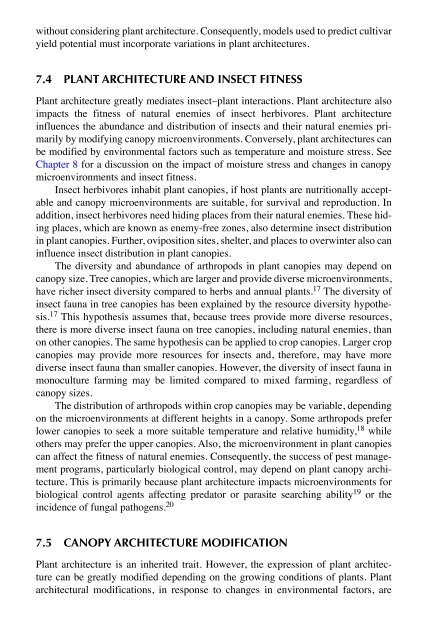Biotic Stress and Yield Loss
Biotic Stress and Yield Loss
Biotic Stress and Yield Loss
- No tags were found...
Create successful ePaper yourself
Turn your PDF publications into a flip-book with our unique Google optimized e-Paper software.
without considering plant architecture. Consequently, models used to predict cultivaryield potential must incorporate variations in plant architectures.7.4 PLANT ARCHITECTURE AND INSECT FITNESSPlant architecture greatly mediates insect–plant interactions. Plant architecture alsoimpacts the fitness of natural enemies of insect herbivores. Plant architectureinfluences the abundance <strong>and</strong> distribution of insects <strong>and</strong> their natural enemies primarilyby modifying canopy microenvironments. Conversely, plant architectures canbe modified by environmental factors such as temperature <strong>and</strong> moisture stress. SeeChapter 8 for a discussion on the impact of moisture stress <strong>and</strong> changes in canopymicroenvironments <strong>and</strong> insect fitness.Insect herbivores inhabit plant canopies, if host plants are nutritionally acceptable<strong>and</strong> canopy microenvironments are suitable, for survival <strong>and</strong> reproduction. Inaddition, insect herbivores need hiding places from their natural enemies. These hidingplaces, which are known as enemy-free zones, also determine insect distributionin plant canopies. Further, oviposition sites, shelter, <strong>and</strong> places to overwinter also caninfluence insect distribution in plant canopies.The diversity <strong>and</strong> abundance of arthropods in plant canopies may depend oncanopy size. Tree canopies, which are larger <strong>and</strong> provide diverse microenvironments,have richer insect diversity compared to herbs <strong>and</strong> annual plants. 17 The diversity ofinsect fauna in tree canopies has been explained by the resource diversity hypothesis.17 This hypothesis assumes that, because trees provide more diverse resources,there is more diverse insect fauna on tree canopies, including natural enemies, thanon other canopies. The same hypothesis can be applied to crop canopies. Larger cropcanopies may provide more resources for insects <strong>and</strong>, therefore, may have morediverse insect fauna than smaller canopies. However, the diversity of insect fauna inmonoculture farming may be limited compared to mixed farming, regardless ofcanopy sizes.The distribution of arthropods within crop canopies may be variable, dependingon the microenvironments at different heights in a canopy. Some arthropods preferlower canopies to seek a more suitable temperature <strong>and</strong> relative humidity, 18 whileothers may prefer the upper canopies. Also, the microenvironment in plant canopiescan affect the fitness of natural enemies. Consequently, the success of pest managementprograms, particularly biological control, may depend on plant canopy architecture.This is primarily because plant architecture impacts microenvironments forbiological control agents affecting predator or parasite searching ability 19 or theincidence of fungal pathogens. 207.5 CANOPY ARCHITECTURE MODIFICATIONPlant architecture is an inherited trait. However, the expression of plant architecturecan be greatly modified depending on the growing conditions of plants. Plantarchitectural modifications, in response to changes in environmental factors, are

















